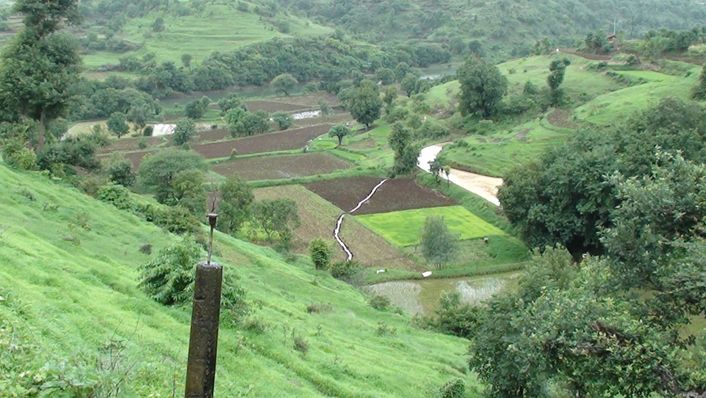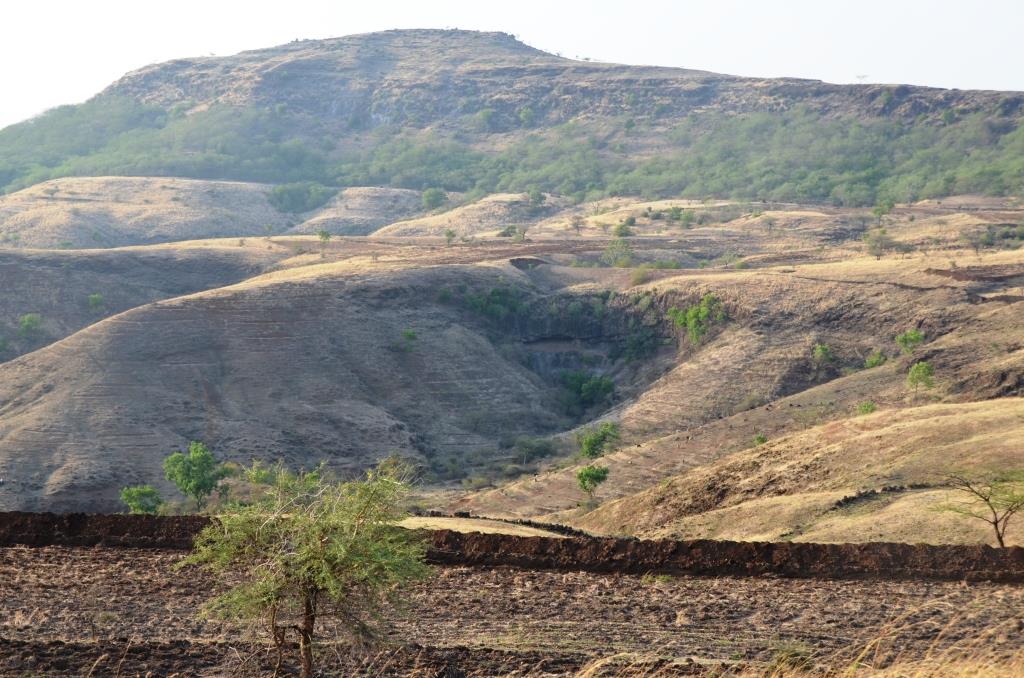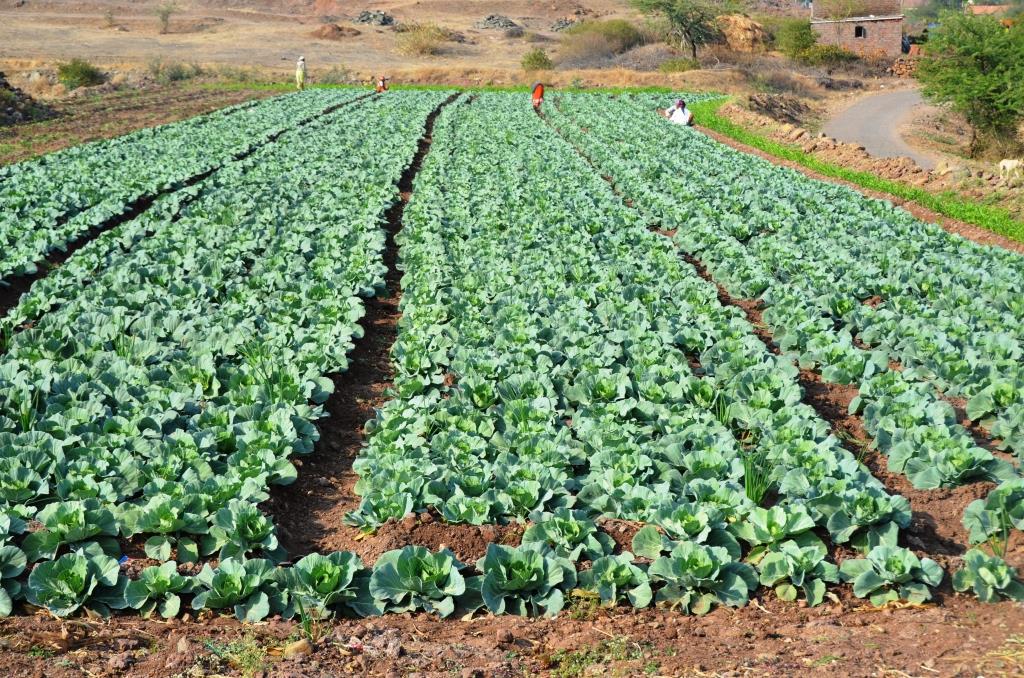by Dr. Sourya Das
People in the rural rainfed areas of India are facing multiple challenges- degradation of land and other natural resources, water scarcity, lack of social empowerment and welfare, unequal distribution of the wealth, high level of vulnerability to climate change, a rapid decline of biodiversity, low agricultural output, lack of local employment, and distressed migration.
While several programmes are tackling these issues, rural problems are generally so closely interconnected that combined, they form a very complex problem. Learnings from our Climate Change Adaptation (CCA) programme highlight that an Ecosystem-based Adaptation (EbA) approach can help.

Background
Historically, communities living in the rainfed areas of Western Maharashtra have been vulnerable, both socially and economically. The people here rely on agriculture and allied activities for their primary livelihoods. However, agriculture is heavily constrained by land degradation, small landholdings, hilly and undulating topography, frequent droughts, and lack of capital to invest, resulting in lower economic returns.
The Akole and Sangamner blocks in Ahmednagar District stand out for their vulnerability. Land degradation, especially soil erosion, was a significant problem. Moreover, the farming practices were unsustainable, leading to low returns and increased pressure on natural resources like land, water, and forest.
In Akole, the majority of the population is tribal. Though it received good rainfall, most of the water drained due to its hilly topography and lack of water harvesting measures. On the other hand, Sangamner, situated in the Western Ghat’s Rain-shadow area, receives low rainfall. Consequently, both regions faced strife due to climate change – droughts, dry spells, delayed monsoons, excess rains, flash floods, and unseasonal rain.

Project Approach
The degradation of natural resources and the lack of capacity of the community to manage the natural resources stood out as two of the main reasons for the vulnerability of the community, especially against the climate change-induced vulnerability.
Consequently, A Climate Change Adaptation (CCA) project was implemented in 25 villages of Akole and Sangamner block of Ahmednagar district of Maharashtra. It was funded by NABARD (National Bank for Agriculture and Rural Development) and SDC (Swiss Agency for Development and Cooperation).
- The project was adopted with some specific strategies—first-the improvement of the natural resource base of the villages. Here, the entire land was treated from the ridge to the valley. Furthermore, community-based natural resource and biodiversity management were introduced.
- Second, through numerous awareness and capacity building measures, participation of the whole community in the different types of institutions was ensured.
- Third, the Water-Stewardship Initiative (WSI) was initiated. Through WSI, the community learnt to prepare their water use plan based on availability. WSI was meant to reduce vulnerability against drought and promote equitable distribution of water resources.
- Fourth, villagers were made aware of and capacitated for implementing climate-resilient agricultural practices.
- Fifth, assistance was provided to the community to diversify their livelihood practices so that the pressure on natural resources was reduced.
- Sixth, linkages to different types of government programmes were improved so that the community could sustain their development by streamlining the project’s learning into the government-induced development programmes.
- Last, women’s empowerment and participation in different institutions and decision-making processes were ensured. The entire project was implemented from 2010 to 2017.

Impact of CCA project
The impact of the project was assessed in 2019-20 with the help of an interdisciplinary study. The study revealed the following:
- The land degradation status of the project villages was found to have improved. Moreover, the improvement in the project villages was found to be better than in a no-project situation. Moreover, villagers perceived that the condition of the soil, water and land had improved considerably when compared to the baseline period and attributed the CCA interventions as the major cause for this change.
- The change in the agricultural condition of the project villages was found to be positive. Villagers were found to be well informed of the efficient use of the soil and water resources to improve cropped area, cropping intensity, productivity, and farmers’ income.
- The dual impact of watershed development and water-stewardship initiative improved water availability in wells and streams- thereby increasing availability for household purposes. The impact was more pronounced in the representative villages of the plateau area of the Sangamner block where the dependence on water tankers reduced drastically. In 2017-18, the villages did not require any water tankers. Moreover, these villages required fewer water tankers in 2018-19, a severe drought-affected year.
- The economic viability of the project was assessed using cost-benefit analysis. It was found that the project villages were in a better position than the control villages- indicating the usefulness of the interventions.
- The cropped area, crop productivity, and requirement of water tankers- across all these indicators, project villages were found to be in a better situation than the control villages through the drought years i.e. 2012-13 and 2018-19.
- It was also found that the rate of community participation and perceived benefit in different types of interventions was very high. The participation rate varied from 90 percent to 60 percent. Moreover, the perceived benefits from CCA interventions were also quite high. The higher amount of participation in a community-based natural resource management project was quite encouraging. Moreover, an almost equal rate of people perceiving benefits from those activities also speaks about its efficacy.
- Most of the villagers interviewed expressed that the CCA project helped them to develop resilience against climate change.

Implications
One of the main striking features of the CCA project is that it incorporated the improvement of the natural resource as a part of the overall CCA interventions. The findings of the study clearly suggest that the project covered three main pillars of the sustainable and holistic approach to climate change adaptation- the Ecosystem-based Adaptation or EbA.
These three pillars are- Participatory Governance, Adaptive Capacities, Ecosystem Services and Biodiversity. Though the project was not fully designed in line of the EbA criteria, it possesses almost all the essential components to be a successful case study of EbA. The restoration of the land and water resources is the key in any area, especially in dryland regions as it forms the basis of any ecosystem and ecosystem services. The economic viability of the project and climate resilience also speaks to its Adaptive Capacities building ability. The high level of participation and perceived benefits from different CCA activities are also indicative of the impact on the Ecosystem and Biodiversity.
Since this project was not developed in line with the EbA, there are some elements where it cannot be completely EbA compliant. For example, the project was not entirely designed to identify all the major ecosystems in the area and regenerate them.
However, the result of the CCA intervention is encouraging from an EbA perspective. It underlines the need to implement EbA with proper assessment of the ecosystems, community needs, and institutions. This is very important from the standpoint of 2020-30, which is the UN decade of Ecosystem Restoration.
Dr. Sourya Das works as Senior Researcher-Economics, and leads the Economics team at the WOTR Centre for Resilience Studies (WCReS). His research interests are the economics of natural resources and ecosystem governance. He has more than 10 years of experience in this field.





